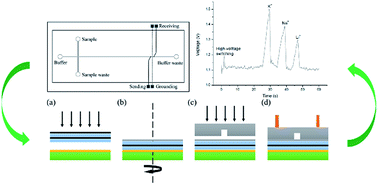A hybrid adhesive bonding of PMMA and PCB with an application on microchip electrophoresis
Abstract
In the development of microfluidics, integration of different materials is becoming critical, especially when the integration of fluidic and electronic components is needed. In this work, a hybrid adhesive bonding method combining adhesive and thermal bonding is proposed. It uses a pressure sensitive adhesive (PSA) tape for integration of a polymethyl methacrylate (PMMA) film and printed circuit board (PCB) substrate while a PMMA microchannel layer is bonded with PMMA film through thermal bonding. The simple bonding process can reliably integrate electronic circuits and fluidic components without any expensive equipment. The relationship between pressure applied during adhesive bonding and the bond ratio is investigated as well as the influence of pressure upon the remaining channel depth during thermocompression. The bond strength is also studied with a dead-end channel test and flow rate test ranging from 20 μl min−1 to 500 μl min−1. The results demonstrate a strong bond formed between the two different layers using the hybrid technique. As an application, a microchip for electrophoresis detection is tested. Successful separation of different ions and a comparable level of the relative standard deviation (RSD) for the migration time and the peak height imply the reliability of the bonding protocol and the good potential for a wide range of applications in the future.



 Please wait while we load your content...
Please wait while we load your content...